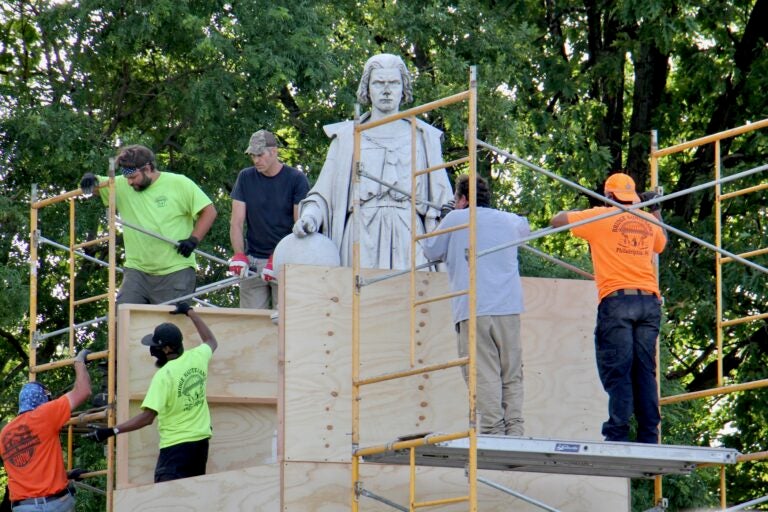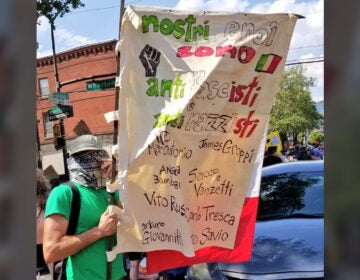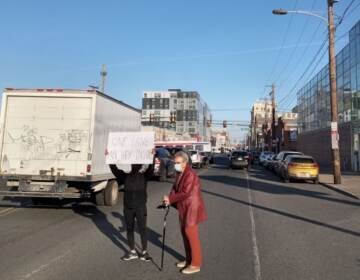City of Philadelphia considers appeal of judge’s decision to let Columbus statue stay
The judge’s decision to block the removal of the statue has less to do with an underlying cultural battle around the monument and more with city protocols.

Workers box up the statue of Christopher Columbus at Marconi Plaza in South Philadelphia. (Emma Lee/WHYY)
A judge blocked the removal of a Christopher Columbus statue in South Philadelphia’s Marconi Plaza that became a flashpoint during protests last year –– but the decision has less to do with an underlying cultural battle around the monument and more with city protocols.
After a bronze edifice of former Mayor Frank Rizzo, an ex-cop whose tenure was defined by the free rein of law enforcement, was removed amid unrest over the murder of George Floyd, some set their sights on the statue of the Italian-born explorer. But while activists wanted the statue gone over Columbus’ historical association with colonialism and slavery, civic and cultural groups in a neighborhood with a large Italian American population opposed removal. The dispute led to public clashes, the removal of the local police captain, and the city’s decision to remove the statue.
The Friends of Marconi Plaza, a nonprofit that supports the park, filed the suit last year against the city’s Board of License and Inspection Review, which had upheld a decision from the Philadelphia Historic Commission approving removal of the statue, which has remained encased in a wooden box since last summer.
On Wednesday, Common Pleas Court Judge Paula Patrick issued an order in support of that appeal. The ruling finds that PHC and the board had committed an “error of law” by affirming removal without a “detailed expert report” on potential damage or other impacts related to the relocation of a “historic” statue.
The order indicates PHC had relied on a two-page document outlining general steps for removal of marble sculptures, and that the primary justification for relocation were “transient” incidents of civil unrest around the statue. Judge Patrick ruled the failure to thoroughly evaluate the impacts to the century-old statue violated the PHC’s own stated purpose to protect historical objects, that relocation could constitute the de facto “demolition” of the statue and, further, that the city failed to allow a typical 90-day public input process.
Barbara Capozzi, a local realtor who was involved with efforts to save the statue, hailed the decision.
“The statue is a point of community pride, Italian American and otherwise,” she said. “It is not harming anyone, removing it will only serve to make a few self-proclaimed ‘woke’ people happy. Thousands of people signed petitions to keep this 157-year-old statue where it has been for many decades.”
Ultimately, Capozzi faulted the city for not following its own procedures for removal of the Columbus statue and the Rizzo statue, which is subject to separate litigation.
Mary Catharine Roper, an attorney with the ACLU of PA, declined to comment on whether the city had followed proper procedure last year, but argued it was squarely within their rights to remove such a monument.
“We agree with the City that it is in the public interest to remove or, failing that, contextualize monuments to historical figures who fostered oppression and slavery of Indigenous people, and Christopher Columbus is certainly one of those figures,” she said. “We support the City’s wish to do that, with the caveat, of course, that due process has to be followed.”
While Columbus’ unquestionably acted in the interests of imperial expansion and there is historical evidence showing his time as colonial governor under the Spanish crown was marked by the brutal treatment and enslavement of Indigenous people, Capozzi described Columbus as a “benevolent” historical figure who had been subject to “rumor and innuendo.”
Still, she said she hoped Patrick’s ruling would be the end of the Columbus issue, and that proponents were working on plans to further preserve the statue by “providing security.”
But it is not clear if it is the end of the statue saga.
“Certainly the city can put together a bigger, stronger case if it wants to, or appeal the decision,” she said. “The city could even include more contextual information nearby about why Christopher Columbus is such a hurtful figure to Indigenous Americans or people of color.”
Mayor Jim Kenney’s office, which ordered the removal, indicated that it was, in fact, considering appealing the decision.
“While we are very disappointed with the ruling, we’re reviewing it now and exploring all potential options — including a possible appeal. The statue remains in Marconi Plaza and will continue to be secured in its existing box,” wrote Kenney spokesperson Kevin Lessard.

Subscribe to PlanPhilly
WHYY is your source for fact-based, in-depth journalism and information. As a nonprofit organization, we rely on financial support from readers like you. Please give today.









